| .... |

Picture
Index
The
illustrations of Bhagavad-gita As It Is were painted by members
of the International Society for Krishna Consciousness (ISKCON) working
under the personal direction of the author, their spiritual master. In
the following descriptive index, the numbers in boldface type which follow
each plate number refer to the chapter and verse of the Gita
that the picture illustrates.
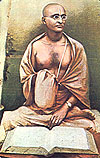 |
Srila Bhaktsiddhanta
Sarasvati Gosvami Maharaja The spiritual master of His Divine Grace
A.C. Bhaktivedanta Swami Prabhupada and foremost scholar and devotee in
the recent age. |
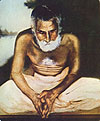 |
Srila Gaura Kisora Das
Babaji Maharaja The spiritual master of Srila Bhaktsiddhanta Sarasvati
Gosvami and intimate student of Srila Thakur Bhaktivinode. |
 |
Srila Thakur Bhaktivinode
The pioneer of the program to benedict the entire world with Krsna consciousness |

Plate 1 |
Bhagavad-gita
1.1 Dhrtarastra is on the throne, and Sanjaya, his secretary, is
describing what is happening on the Battlefield of Kuruksetra. Because
of Sanjaya's mystic powers, the discourse on the battlefield between Krsna
and Arjuna is revealed in his heart. |

Plate 3 |
Bhagavad-gita
1.3 A view of the military phalanx on the Battlefield of Kuruksetra.
The chariot of Krsna and Arjuna is in the midst of the two armies. |
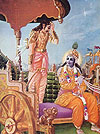
Plate 5 |
Bhagavad-gita
1.26-29 Arjuna laments upon seeing his relatives standing opposed
to him in battle. Krsna, smiling, is ready to console His friend by His
transcendental teachings. |
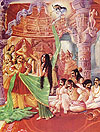
Plate 6 |
Bhagavad-gita
1.33-35 Draupadi, the wife of the Pandava brothers (Arjuna, Maharaja
Yudhisthira, Bhima, Sahadeva and Nakula), is being disrobed by Duryodhana
and Duhsasana, two sons of Dhrtarastra, after being lost to them in a gambling
match. Dhrtarastra is sitting on the throne. Krsna is becoming Draupadi's
infinite robe to save her from being seen naked by the assembly. Because
of this incident and other offenses to the Pandavas, Krsna wanted the battle
to take place and the miscreants to be killed. |
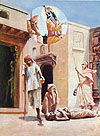
Plate 7 |
Bhagavad-gita
2.11 A devotee of the Lord comes upon a man lying dead on the ground
and beside him two other men in conditions of bodily misery. |

Plate 8 |
Bhagavad-gita
2.13 The conditioned spirit soul is seen changing bodies from childhood
to youth to old age to death and then into the womb of another mother.
Verse 22 is also illustrated by this same picture. Above, a man is changing
garments, and below the soul is changing bodies. |
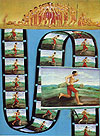
Plate 9 |
Bhagavad-gita
2.13 The many, many frames on a reel of movie film, when seen consecutively,
appear as one picture on the screen, although there are actually many different
pictures. Similiarly, we see a man as localized (above), but actually his
body is changing at every second. All this is happening without the notice
of the viewer. However the soul within the heart (seen as a sparkling star)
does not change; he remains eternally the same. |
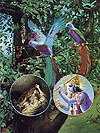
Plate 10 |
Bhagavad-gita
2.22 The bird on the left is captivated by the fruits of the tree,
while the friendly bird on the right acts as witness and waits for His
friend to turn to Him. |

Plate 11 |
Bhagavad-gita
2.62-63 The path of destruction of the conditioned soul's intelligence
due to dictation of the senses and mind is portrayed. |
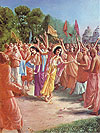
Plate 12 |
Bhagavad-gita
3.10 Lord Caitanya, wearing yellow robes, leads thousands of followers
in the congregational chanting of the holy names of Sri Krsna. His four
associates are:
-
Nityananda Prabhu, wearing
purple robes, at Lord Caitanya's immediate right.
-
Advaita Prabhu, wearing
white robes, at Nityananda's immediate right.
-
Gadadhara Pandit at Lord
Caitanya's immediate left.
-
Srivasa Pandit at Gadadhara's
immediate left.
|

Plate 13 |
Bhagavad-gita
3.12 Devotees are pictured engaging in sankirtana-yajna.
Above the clouds are the demigods, and above them the Lord, who is pleased
by the singing of His holy names. The demigods are, left to right, Candra
(the moon-god), Indra (the god of rain), Vivasvan (the sun-god) and Vayu
(the god of air). At the right is Laksmi, the goddess of fortune. |

Plate 14 |
Bhagavad-gita
3.37-39 The living entity in the center is being enveloped by fiery
lust. The analogy in verse 38 is illustrated here. At the top is fire covered
by smoke, symbolizing human life. At the bottom left is a mirror covered
by dust, symbolizing animal life. At the bottom right is an embryo covered
by the womb, symbolizing tree and plant life. |
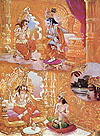
Plate 15 |
Bhagavad-gita
4.1 At the top, Krsna teaches the science of Bhagavad-gita
to Vivasvan, the sun-god. Below Vivasvan teaches his son, Manu, and in
the circle at the right, Manu teaches his son Iksvaku. |
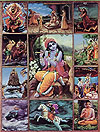
Plate 16 |
Bhagavad-gita
4.7 In the center square, Krsna is shown in His original two-handed
form, holding a flute. Surrounding Him are ten of His eternal incarnations,
pictured in the order in which they appear in the material world, beginning
clockwise from the lower left-hand corner.
-
Matsya, the fish incarnation,
is saving the Vedas.
-
Kurma, the tortoise incarnation,
is holding the hill on His back.
-
Varaha, the boar incarnation,
is fighting with the demon Hiranyaksa.
-
Nrsimhadeva, the lion
incarnation, is killing the demon Hiranyakasipu.
-
Vamanadeva, the dwarf
incarnation, is begging some land from King Bali.
-
Parasurama is killing
the demoniac ksatriyas.
-
Lord Ramacandra is going
off into exile with His wife, Sita, and brother, Laksmana.
-
Krsna is lifting Govardhana
Hill, and beside Him is His brother Balarama.
-
Lord Buddha.
-
Lord Kalki is riding on
His horse, killing all the demons and thus liberating them.
|
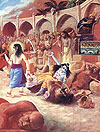
Plate 17 |
Bhagavad-gita
4.8 Krsna's uncle, Kamsa, is being killed by the Lord, Balarama,
Krsna's brother, is standing on Krsna's right. Behind Krsna are His parents,
Devaki and Vasudeva, who were imprisoned by Kamsa but are here freed by
their son. This scene takes place in Kamsa's wrestling arena in Mathura
province. |

Plate 18 |
Bhagavad-gita
4.11 At the top Krsna is dancing with His purest devotees as a
lover. On the lotus petals the Lord is reciprocating with His devotees
as a son, as a friend and as a master. Below left, a devotee in the material
world is associating with Krsna personally by painting His transcendental
form. Next, an impersonalist, by his meditation, is merging with the brahmajyoti,
the spiritual effulgence emanating from the Lords body. On the right a
mystic yogi is walking on the water. On the far right a fruitive
worker is receiving the fruits of his labor. |

Plate 19 |
Bhagavad-gita
5.4-6 Above, a devotee is engaged in various devotional activities
for the Deities (authorized incarnations of the Lord, who comes in this
form to accept our service). Below, a sankhya-yogi engages in the
analytical study of matter and spirit. After some time he realizes the
Lord (the forms of Radha and Krsna include all other forms of the Lord)
within his heart, and then he engages in devotional service. |

Plate 22 |
Bhagavad-gita
6.24 The little sparrow is shown here trying to drink up the ocean
to retrieve her eggs. Because of her determination, Lord Visnu has sent
Garuda, who is standing behind her, to threaten the ocean into giving up
the eggs. |
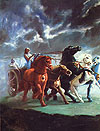
Plate 23 |
Bhagavad-gita
6.34 The chariot of the body. The five horses represent the five
senses (tongue, eyes, ears, nose and skin). The reins, the driving instrument,
symbolize the mind, the driver is the intelligence, and the passenger is
the spirit soul. |

Plate 25 |
Bhagavad-gita
7.4-5 Spirit soul sustains the material universe of earth, water,
fire, etc. (represented as the body). The subtle body-mind, intelligence
and fales ego-is represented by the red dot on the forehead. The soul is
seated in the heart of the gross body. |
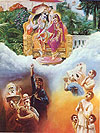
Plate 26 |
Bhagavad-gita
7.15-16 At the top Laksmi-Narayana are shown in the Lord's transcendental
abode. Below are four kinds of miscreants who do not surrender to God and
four kinds of pious men who turn to Him in devotional service. |
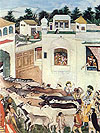
Plate 27 |
Bhagavad-gita
8.21 Krsna brings His thousands of surabhi cows back home
from the fields at the end of the day. |

Plate 28 |
Bhagavad-gita
9.11 The fools mock the humanlike form of Lord Krsna, but the devotee
offers his obeisances. Behind Krsna are Maha-Visnu, Garbhodakasayi Visnu
and the entire cosmic manifestation-all working under Krsna's direction. |
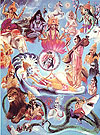
Plate 30 |
Bhagavad-gita
10.41 A sampling of Krsna's infinite manifestations, both in the
spiritual and material worlds. Outer circle (clockwise beginning from the
upper left-hand corner): Indra carrying the thundrebolt, the Himalayas,
Lord Siva with the Ganges River in his hair, the moon, the horse Ucchaihsrava,
the transcendental om, Kapila, Rama, flower-bearing Spring, Kamadhuk,
Arjuna, Vyasadeva, Prahlada, the shark, Vasuki, Skanda, Varuna, Yamaraja,
the lion, Kuvera, Agni and Airavata. Inner circle, clockwise (beginning
from four-headed Lord Brahma sitting on the lotus flower): Brahma, Narada,
Garuda, the sun, the ocean, Lord Visnu, Ananta, and the chanting of the
holy names-Hare Krsna, Hare Krsna, Krsna Krsna, Hare Hare/ Hare Rama, Hare
Rama, Rama Rama, Hare Hare. |
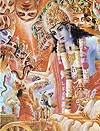
Plate 31 |
Bhagavad-gita
11.13 Krsna's universal form is displayed to Arjuna. Still the
Lord does not loose His original eternal identy,. He remains seated on
the chariot with Arjuna. |

Plate 32 |
Bhagavad-gita
11.50 After showing Arjuna His universal form, Krsna shows him
His four-handed Narayana form in which He presides over all the spiritual
planets. Then He changes to His two-handed form to show everyone that He
is the source of the universe and the source of Narayana. |
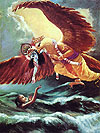
Plate 33 |
Bhagavad-gita
12.6-7 Krsna is riding towards the devotee on Garuda, His feathered
carrier,. In order to lift him out of the ocean of birth and death. |

Plate 34 |
15,
18
life in the higher planetary system, life in the society of human beings
and life in the animal kingdom are portrayed. |
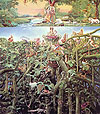
Plate 35 |
Bhagavad-gita
15.1-3 Krsna and His eternal consort, Radharani, are shown in Their
eternal abode, Goloka Vrndavana. The upside-down tree below Them is the
banyan tree, representing the material world, which is a perverted reflection
of the spiritual world. The demigods are on the top branches, the human
beings are on the middle branches, and the animals are on the lower branches.
On the right a man is disentangling himself from the tree by cutting it
with the weapon of detachment. |
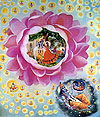
Plate 36 |
Bhagavad-gita
15.6 The huge lotus is the original spiritual planet, Goloka Vrndavana,
the abode of Radha and Krsna. The spiritual effulgence around this planet
is the brahmajoyti, which is the ultimate goal of the impersonalists.
Within the universal brahmajoyti are innumerable spiritual planets
which are dominated by plenary expansions of Lord Krsna and inhabited by
ever-liberated living beings. Sometimes a spiritual cloud overtakes a corner
of the spiritual sky, and the covered portion is called mahat-tattva,
or the material sky. The Lord, as Maha Visnu, lies down in the water within
the mahat-tattva, which is called the Causal Ocean. Maha Visnu enters
each universe as Garbhodakasayi Visnu and lies in the Garbha Ocean on the
serpentine Sesa incarnation. From His navel a lotus stem sprouts, ad d
on the lotys, Brahma, the Lord of the universe, is born. Brahma creates
all the living beings in different shapes in terms of their desires within
the universe. He also creates the sun, moon and other demigods. |

Plate 37 |
Bhagavad-gita
15.8 Top section: On the left, a boy is dancing before the Deities
of Radha-Krsna. The result of such devotional consciousness is shown on
the right, where he is dancing with Krsna as a playmate in the Lord's spiritual
abode. Second section: On the left a man is offering charity to a brahmana;
on the right he has taken the body of a demigod and is enjoying heavenly
delights. Third section: A man is eating meat and other abominable foods;
in his next life he is seen in the body of a hog who eats anything and
everything. Bottom section: A man is approaching a women with lust. This
bestial consciousness carries him to a dog's body. |

Plate 38 |
Bhagavad-gita
16.5, 21
Two men (standing where the stairway makes its turn) are being offered
both liberation and bondage. One man looks upward, following the spiritual
master who points toward Sri Radha-Krsna. The other man embraces the demoniac
qualities by accepting the garland offered by Maya, Krsna's illusory energy.
Drawn by ropes which are held by the personifications of lust, greed, and
anger, he follows her down the steps. At the bottom he is reaching for
Maya, and gliding towards hell. |

Plate 40 |
Bhagavad-gita
17.4 On the top, three demigods, Vivasvan, Brahma and Lord Siva,
are being worshipped by their respective devotees. Just below a man is
worshipping a famous mundane personality. At the bottom, women are worshipping
a tree which is inhabited by a ghost, and a man is worshipping the tomb
of a dead man. |

Plate 41 |
Bhagavad-gita
18.14 Endeavor means energy which is employed. For anything one
does there must be some activity; that is the endeavor. The place must
be favorable, the activities must be authorized, the doer (the man who
is acting) must be expert, the instruments must be fit, and the help from
the Supersoul must be adiquate. These are the five causes for success,
and the opposite are the five causes for failure.
Here a man is conducting
business. If he goes to the marketplace it will be very nice, since there
are so many customers. Similarly, one looking for spiritual life goes to
where there are devotees and associates with them. One must go to a particular
type of place for a particular type of activity, and the person acting
must be well-versed, or expert, just like an expert salesman whose method
of business is bona fide. The senses must be in order, to guard against
cheating, hear offers, etc. Above all is the help from Supersoul, who dictates
in such a way that everything is successful, spiritually or materially.
Among the five factors portrayed here, the endeavor is the business which
is being conducted. |
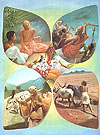
Plate 42 |
Bhagavad-gita
18.41-46 While engaged in their prescribed duties, these four representatives
of the four social orders (varnas) are thinking of Lord Krsna and
offering Him the results of their work. |
 |
Bhagavad-gita
18.78 Arjuna's illusion is now gone, and he is acting according
to Krsna's instructions. Krsna, the driver of countless universes, is driving
the chariot of Arjuna. |

|



